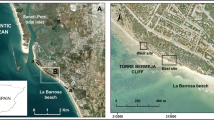Abstract
The scope of this work is to present an integrated methodological multi-scale and multi-temporal approach for the study of ancient monuments in their environmental context. The presented work showcases the interdisciplinary research experience gained during the last years by the Remote Sensing and Geo-Environment Lab (ERATOSTHENES Research Centre) of the Cyprus University of Technology. The developed capabilities of the Eratosthenes Research Centre derived from the successful implementation of various national and European research projects within the wider area of architectural heritage study and protection. In this framework geospatial tools, earth observation and in situ monitoring and measurements were merged and further investigated. The case study concerns Paphos town in Cyprus and particularly the archaeological site of Nea Paphos and the Hellenistic necropolis “Tombs of the Kings”, a UNESCO World Heritage site.
The study encompasses a variety of technological tools to approach the area of interest, moving from a landscape level to isolated monument scale. For the landscape approach, novel, earth observation (macro scale) and aerial image (semi-macro scale) processing techniques have been employed, while in a monument level, the study extents from the geometric documentation of a tomb to the image processing for the mapping of surface weathering features, as well as to the seismic performance of single monuments (micro scale). The overall results demonstrate that such geospatial data linked to the individual characteristics of each monument can assist towards the implementation of various directives and conventions, while offering an integrated understanding of the monuments state of preservation, seen not as an isolated unit, but as part of their natural and anthropogenic context, which inevitably affects their viability in time and place.
Access this chapter
Tax calculation will be finalised at checkout
Purchases are for personal use only
Similar content being viewed by others
References
Negula ID, Sofronie R, Virsta A, Badea A (2015. 2210–7843) Earth observation for the world cultural and natural heritage. Agric Agric Sci Procedia 6:438–445. https://doi.org/10.1016/j.aaspro.2015.08.114
Hernandez M, Huth U, Schreier G (2008) Earth observation from space for the protection of UNESCO World Heritage sites: DLR assisting UNESCO. Int Arch Photogramm Remote Sens Spat Inf Sci XXXVII, Part B8. Beijing:643–646
Nagendra H, Mairota P, Marangi C, Lucas R, Dimopoulos P, Honrado JP, Niphadkar M, Mücher CA, Tomaselli V, Panitsa M, Tarantino C, Manakos I, Blonda P (2015) Satellite Earth observation data to identify anthropogenic pressures in selected protected areas. Int J Appl Earth Obs Geoinf 37:124–132., ISSN 0303-2434. https://doi.org/10.1016/j.jag.2014.10.010
Agapiou Α, Lysandrou V, Alexakis DD, Themistocleous K, Cuca B, Sarris A, Argyrou N, Hadjimitsis DG (2015) Cultural heritage management and monitoring using remote sensing data and GIS: the case study of Paphos area, Cyprus. CEUS Comput Environ Urban Syst 54:230–239. https://doi.org/10.1016/j.compenvurbsys.2015.09.003
Agapiou Α, Nisantzi A, Lysandrou V, Mammouri R, Alexakis DD, Themistocleous K, Sarris A, Hadjimitsis DG (2013, August 5) Mapping air pollution using Earth Observation techniques for cultural heritage. In: Proceedings SPIE 8795, first international conference on remote sensing and geoinformation of the environment (RSCy2013), 87950K; https://doi.org/10.1117/12.2028234
Agapiou A, Lysandrou V, Themistocleous K, Hadjimitsis DG (2016) “Risk assessment of cultural heritage sites clusters using satellite imagery and GIS: the case study of Paphos District, Cyprus”, Applications of Geoinformatics for the prevention and mitigation of natural hazards. Nat Hazards 83(1):5–20. https://doi.org/10.1007/s11069-016-2211-6
Agapiou A, Alexakis DD, Sarris A, Hadjimitsis DG (2016) Colour to grayscale pixels: re-seeing grayscale archived aerial photographs and declassified satellite CORONA images based on image fusion techniques. Archaeol Prospect 23(4):231–241. https://doi.org/10.1002/arp.1536
Kyriakides N, Lysandrou V, Agapiou A, Illampas R, Charalambous E (2016) Correlating damage condition with historical seismic activity in underground sepulchral monuments of Cyprus. J Archaeol Sci Rep. https://doi.org/10.1016/j.jasrep.2016.07.007
Lysandrou V, Agapiou Α, Hadjimitsis DG (2015, June 19) Impact of modern evolution of Paphos town to its ancient necropolis. A multi-temporal GIS and earth observation analysis. In: Third International Conference on Remote Sensing and Geoinformation of Environment, 95350Y. https://doi.org/10.1117/12.2192514
Open initiative on the use of space technologies to support the World Heritage Convention, UNESCO website, http://www.unesco.org/science/remotesensing/?id_page=135&
Acknowledgement
The present paper is under the Athena project. This project has received funding from the European Union’s Horizon 2020 research and innovation programme under grant agreement No 691936 and work programme H2020 under “Spreading Excellence and Widening Participation”; call H2020-TWINN-2015: Twinning (Coordination and Support Action). Acknowledgment is due to the Director of the Department of Antiquities Dr. Marina Solomidou-Ieronymidou for supporting research by granting all necessary permissions and access to the sites.
Author information
Authors and Affiliations
Corresponding author
Editor information
Editors and Affiliations
Rights and permissions
Copyright information
© 2018 Springer International Publishing AG, part of Springer Nature
About this chapter
Cite this chapter
Lysandrou, V., Agapiou, A., Kyriakides, N., Hadjimitsis, D. (2018). From Space to Ground. Digital Techniques for the Investigation of Monuments and Sites. In: Koui, M., Zezza, F., Kouis, D. (eds) 10th International Symposium on the Conservation of Monuments in the Mediterranean Basin. MONUBASIN 2017. Springer, Cham. https://doi.org/10.1007/978-3-319-78093-1_65
Download citation
DOI: https://doi.org/10.1007/978-3-319-78093-1_65
Published:
Publisher Name: Springer, Cham
Print ISBN: 978-3-319-78092-4
Online ISBN: 978-3-319-78093-1
eBook Packages: Chemistry and Materials ScienceChemistry and Material Science (R0)




